| SUMMER 2016
1. What
brought you to the Topps company back in the day and how quickly did you start
working within the NPD (New Product Development) department? What were some of
the first Topps projects that you worked on for them?
To backtrack a little: I enrolled at the School of Visual Arts in NYC in
1978. Part of what brought me there was the cartooning faculty, specifically Harvey
Kurtzman, one of the masters of the medium and a personal hero (and via Mad,
the main influence on the kind of satiric products that Topps was known for.)
Art Spiegelman; an underground cartoonist who also worked for Topps for many years,
was teaching comics history there at the time and I got to know him through that.
When Art launched Raw magazine in 1980 I was one of three students (along
with Drew Friedman and Kaz) invited to contribute. I remained involved, performing
editorial and production duties.
In the early 1980s Topps was ostensibly
looking to bring some "young blood" into their New Products Development
department (the dank cluster of cubicles from whence all Topps non-sports projects
sprung.) My first assignment arrived in the form of a frantic phone call from
Art one Friday afternoon during the summer of 1982, shortly after graduation.
NPD desperately needed copy for a complete set of 88 of Jaws 3-D bubble
gum card backs first thing Monday morning. Evidently Universal wasn't coming through
with a script on time and although they had photos, nobody had a clue what the
narrative was supposed to be. So Topps wanted something, anything, else
as backup. As directed, I went to the local public library, researched shark and
sting-ray and Portuguese man-o-war jellyfish data, concocted a Ripley-like format
entitled "Fun Facts About Fish" and delivered all 88, first thing Monday
morning. I was immediately told that the script had just shown up and the work
was no longer needed.
Not too long afterward I found myself invited back
one or two days per week and put to work on whatever (NPD creative director) Len
Brown needed help with at the moment. Early projects included one of Topps' endless,
futile, stupid attempts at "modernizing" Bazooka Joe, transforming generic
Spanish import candy packaging into Bazooka Bubble Gum Pops, grinding out "hip"
concepts for pinback buttons based on popular song titles ("You can't copyright
a song title!"), and brainstorming ideas for cheap plastic candy novelty
containers. One of my first; Pow! Powder (a powder candy-filled anarchist
bomb with a fuse) was OKed and put into production. So, I guess I was doing OK
too and stuck around. The next thing I knew I was working on a revival of Wacky
Packages (a childhood favorite) and eventually through that, GPK.

BOOKS OF WONDER : NEWGARDEN'S BOW-WOW'S NIGHTMARE NEIGHBORS
(2014) © MARK NEWGARDEN
CREATIVE
CONSULTANT PREVIOUSLY AT TOPPS: EDITOR, ART DIRECTOR, WRITER, ETC.; CO-CREATOR
OF GPK
2.
What's the juxtaposition like as an artist, working in a corporate-type environment
with rules and regulations and also wanting your own personal creative juices
to flow? Were the Topps assignments and the GPK releases rewarding for you? It
was a double-edged sword, but I really did put a lot of personal creative energy
into Topps projects, especially once GPK was underway. I'm sure I was the first
GPK fan. I was actively engaged and protective of it from the start. I was young
(and naïve?) and found it stimulating work. Older (and possibly wiser) folks
may have held back more and stuck to the playbook. But I didn't know the playbook.
I was always one for pushing the envelope a little I guess, and lucky to be in
situation that sometimes allowed for it. Topps, in those days was nominally "corporate",
but it really wasn't Corporate. It was a unique, idiosyncratic parallel universe
unto itself; a truly dysfunctional family business.
There were plenty
of built-in frustrations there to be sure, but also plenty of opportunity to balance
them out, because I was never really a Topps nine-to-four-thirty-er. I kept busy.
When I started there I was also still working on RAW, co-editing it's sister
'zine Bad News, illustrating and creating strips for NYC alt-weeklies like
The East Village Eye and The Village Voice. By 1988, I was teaching
at SVA myself and had a weekly slot in the NY Press, but still putting
in my 3 days a week at Topps. Topps was cheap, but it basically covered my cheap,
1980s Brooklyn rent. 3.
With your cartoonist background, how much of this were you able to transition
over to your Topps jobs?
Well, I
was just starting out but it was a very easy fit. I had the right resume I guess:
SVA cartooning grad, comics history nut and former teenage fortune cookie author.
NPD was basically a playpen for pop-culture geeks and hungry, irreverent cartoonists.
Besides that, I was the oldest of 6 children, still living at home and had a direct
pipeline into contemporary kid culture - which was a valuable commodity at Topps.
If not actively fed or cultivated, that connection to "what kids like"
is a perishable asset. Once you lose it, you might as well be 87 years old and
telling kids mother-in-law jokes in Yiddish.
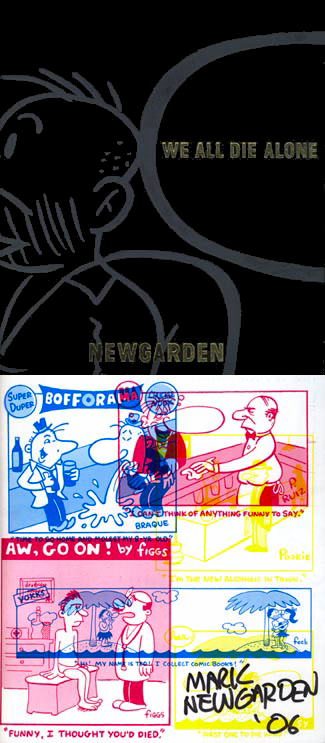
NEWGARDEN'S
BRILLIANT VELVET HARDCOVER WE ALL DIE ALONE 2006 BOOK
NOTE: THIS HAS
A SHORT, ALBEIT EXCELLENT, GPK SECTION
4. Before Jay Lynch jumped on board with later GPK releases,
you and Art Spiegelman worked on writing the satire on the early GPK releases
for the card backs … was there any particular set that sticks out the most
for you or felt the most rewarding?
As I recall, Art really didn't
get too involved in the card backs, per se. He was usually there just one day
a week and other issues demanded more attention. I do remember having fun with
those giant GPK 5"x7" stickers, both fronts and backs. And the poster
series too. There was more real estate to cover in those formats, so they were
a little more ambitious, I guess. Both projects were squeezed in between regular
GPK series and set on particularly hairy, almost absurd schedules. I remember
having to put in a lot of extra time and effort to see them completely through
the sausage grinder.
5.
Most diehard GPK collectors are aware of the rigmarole surrounding the court case
and settlement between 'CPK'/OAA and 'GPK'/Topps; with a lot of documentation
turned into the lawyers for discovery … was there anything left unmolested?
What was your take on the whole case?
It was a bit unnerving. There was a lot of emergency closed-door meetings
and palpable anxiety. Most of my GPK drawings vanished from the office overnight,
never to be seen again. (A lot of them eventually reappeared in the form of 4th
generation Xeroxes with court exhibit numbers stamped allover them.) They didn't
want me testifying. They didn't want Art testifying.
Ultimately, Arthur
Shorin, Len Brown and John Pound all went to Atlanta. We heard they were not getting
good "vibes" from the Court down there, and Arthur decided it was provident
to settle. I think we might have suspended work on the cards for brief time, but
it wasn't for very long. The full terms were never disclosed to us, but they included
a title change and a redesign to avoid the look of their "soft-sculpture"
dolls. Hence the new plastic, jointed-doll Garbage Gang design. [ed. note: The
Garbage Gang title was used for the comic backs after the lawsuit and as the GPK
name for international releases.]
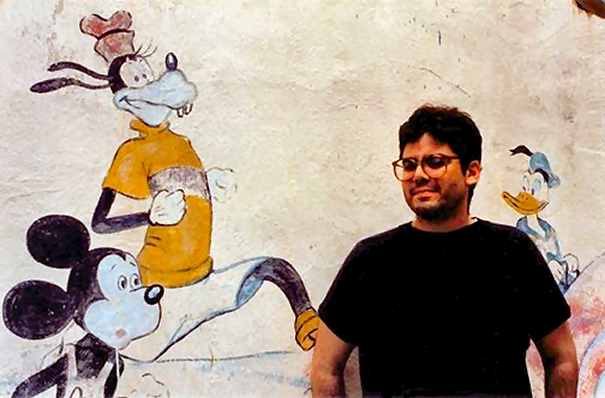
NEWGARDEN,
CIRCA 1980s © MARK NEWGARDEN
6.
What was it like working with the many artists involved in creating GPK? Correspondence
and communications is so different now-a-days; I would imagine receiving Pound's
paintings with paint strokes would be a lot different than receiving a scanned
electronic image these days. Can you explain the teacher/student relationship
you had with Spiegelman and were you comfortable directing the GPK artists? I
have to say, the original sets are untouchable when it comes to the level of quality
(even printed on lesser-grade card).
There was always a lot of creative back and forth, it was a big part of the
job. Phone meetings, faxes, Fed-Exed tracing paper overlays with notes. Art and
I were usually on the same page. John's pencils or paintings would come in on
a Monday and I'd make notes all over them. Then on Tuesday, Art would make notes
on my notes and we'd usually call John in the afternoon and hash it all out. Tom
Bunk and James Warhola were local, so they'd take the subway. We'd all do lunch
in the fabled Topps cafeteria and then go through the same routine in person.
At times (when there was time) we'd go through 2, 3, even 4 rounds of revisions
on a single image to get it just right. The input usually focused on emphasizing
clarity and amplifying (or extending) the gag. The goal was always to balance
impact with visual clarity. May sound obvious, but it really isn't always so simple.
The initial staging or composition of a GPK gag was crucial as to whether it lived
or died. Then the execution needed to be solid and plausible and never distract,
or get in the way of the concept. John set a very high bar from the start. Tom
[Bunk] brought a wacky energy to the mix. James [Warhola] added an air of foreboding
mood and mystery. Seeing what these guys would come back with was always the highlight
of my week. It was fun and collaborative, and I think our fresh eyes and brain
cells helped make better GPKs.
7.
I've always been enamored by GPK and have highly admired the GPK artists behind
the card artwork; the main goal for the site was to give credit where credit was
due; it's been a lot of rewarding years digging up information. Was there anything
you were able to take away from the GPK project after it wrapped? Any keepsake
of sorts that you had to have?
I
normally keep comprehensive "process" files for the various projects
I work on. (In fact, I have often used GPKs to illustrate the concept/ thumbnail/
sketch/ finish stages of illustration in the classroom.) One artifact I tripped
across again recently was a spiral notebook that I kept in 1984, while working
on Wacky Packages, with my lists of products with parody potential and the initial
gag concepts for each of them. Most of the major food conglomerates had sent Topps
"cease and desist" letters over the years and their brands were considered
off limits for Wacky Packages, so part of my job was to suss out new products
from manufacturers that were (hopefully) less litigious. I have fond memories
of walking the isles of Toys-R-Us on Bay Parkway with Len Brown, scouting prospects
and jotting them down. This page is where "Garbage Pail Kids" first
saw the light of day.
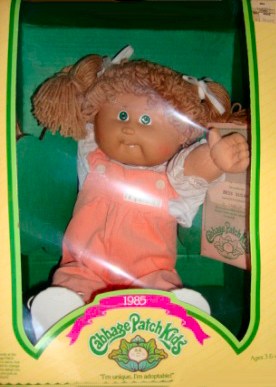
CPK
: "I'M UNIQUE, I'M ADOPTABLE" PACKAGE COPY

NEWGARDEN'S WACKY PACKAGES NOTEBOOK WITH CONCEPT IDEAS
AND PARODY PACKAGING TAGLINES
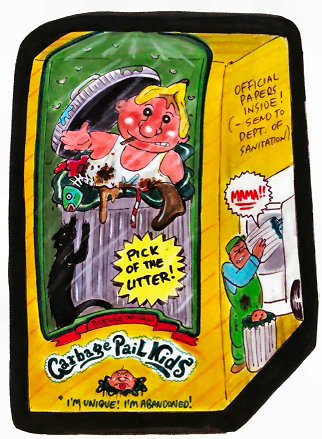
NEWGARDEN'S WACKY PACKAGES GPK CONCEPT
8. What
was Topps' reasoning behind adding new artists like Tom Bunk, Mae Jeon and David
Burke during the 3rd Series? Was this foreshadowing on their behalf knowing that
John Pound wouldn't be able to keep up with the release schedule? Those sets started
to be printed every 3-4 months or so like clockwork.
During work on series 2, we got word from the Topps suits that GPK was REALLY
taking off. So the garbage was hitting the fan and NPD basically had to gear up
for mass production. The powers that be wanted more GPKs faster, with less reliance
on any individual. Tom Bunk was onboard with GPK right from the start, illustrating
the backs. Meanwhile he had honed his rendering skills on a similar Topps series
entitled Gross Bear Buttons, which had developed alongside GPK, but on a slower
track. Tom switched over to painting GPKs just as we were ramping up for series
3. Mae Jeon worked in Ben Solomon's art department (where they airbrushed baseball
player's warts.) When the push was on, there was some pressure to try her out
on GPK paintings. She wasn't a cartoonist, so she was given a couple of John Pound's
pencil sketches to work with. David Burke, a fledgling illustrator, was also assigned
a handful of concepts around this time. We tested out a number of others as well,
but Pound, Bunk and Warhola ultimately became our GPK dream team. 9.
The early GPK sets seem more hands-on for the art directors, in general. Creating
new product and recycling old material for the card backs. Were the later releases
just as hectic, or was there a team in place where the group was working like
a well-oiled machine? How thrilled were you of these new changes in features?
By a certain point, maybe series 3 or so, GPK had pretty much become the
only thing I worked on at Topps. Once the formula and the team were in place,
the pace relaxed a little into a more evenly paced workflow. It could still get
hectic as deadlines loomed, but we knew where we were going. I think the quality
and cleverness of the images improved in many ways, but on the whole they also
lost some of that initial iconic strength in the process, especially after the
lawsuit and redesign. They were less appealing and there was also a little bit
of a loss of visual continuity for the seasoned collectors.
10.
Collectors were lucky the settlement allowed the 8th and 9th Series GPK to be
released, since they were 'completed'; but we weren't so lucky with the 16th Series
release. Do you feel GPK had run its course at that point? That is quite a few
years working on a project and I'm sure the brain wants to exercise its creative
side (in other areas). Were you looking forward to different projects, or personal
work?
Some of the fun probably evaporated over time, which is
only natural when you are constantly doing a variation of the same thing. It was
never boring, but it could sometimes feel like an abstract problem-solving exercise.
"OK, what can we do with vomit today?" (Admittedly, not the worst
job in the world to have.)
Keep in mind that every GPK series was always
considered to be the "last one." Topps never imagined there would be
a need for a "next" GPK series - until the new set flew off the shelves.
AGAIN. Then they needed that next series by Monday morning. It was almost a joke.
About midway through, Len Brown predicted that we would squeeze the same number
of series out of GPK as Topps had done with the original Wacky Packages, and he
was correct. In the end, I think GPK ran its natural course. It was a fad, and
that generation grew up and moved on. In retrospect it was a pretty good run,
we ultimately produced 16 series (about 660-something images) and a host of product
extensions and spin-offs. (I'm obviously not including later re-pops here, which
are more like niche products, created by and targeted at die-hard fans.)
After GPK, there was some room for new directions and a lot of experimentation
in NPD and that was exciting. Some ambitious products, like Toxic High, Pee-Wee's
Playhouse and Gruesome Greetings made it out into the world more or less intact,
but a lot of truly excellent projects (Ugly Americans, Loco-Motion, Wanted Posters
and at least new 2 new Wacky Packages sets) were green-lit, completely executed,
and, for reasons I still do not completely understand, put on the shelf and never
released. Topps, as a corporate entity, was in flux. They were leaving the gritty
Brooklyn waterfront for Wall Street, and to me it a signal that the time was right
to move on. 11.
Any thoughts on the lasting impact GPK has had on our nostalgic psyche and is
it strange for you to be re-living the fad after so many years?
I think that for those of us that were part of it, GPK has never quite gone
away entirely. Our kids are still out there bouncing around on the far edges of
the culture somewhere, poised to vomit down on us all over again, whenever we
least suspect it.
NOTE: EXAMPLE OF NEWGARDEN'S "CONCEPT/ THUMBNAIL/ SKETCH/
AND FINISH STAGES" OF ILLUSTRATION USED IN THE CLASSROOM

'STAR'
# = LAWSUIT EXHIBIT NUMER (PHOTOCOPY)
'ARROW' = NEWGARDEN'S HORIZONTAL CONCEPT
NAME
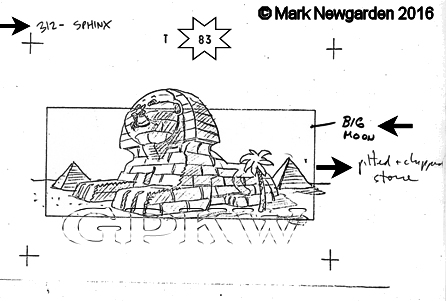
'STAR' # = LAWSUIT EXHIBIT NUMER (PHOTOCOPY)
'ARROW' (1ST)
= POUND'S HORIZONTAL THUMBNAIL W/ CONCEPT NAME : (312) '3' = SERIES 3; '12' =
TWELFTH IMAGE
'ARROW' (2ND) = NEWGARDEN'S COMMENTS AFTER SUBMISSION: "BIG
MOON"; AS SEEN IN THE CONCEPT
(IMAGE ENDED UP W/ A DAYTIME SCENERIO)
'ARROW' (3RD) = SPIEGELMAN'S COMMENTS: "PITTED + CHIPPED STONE"
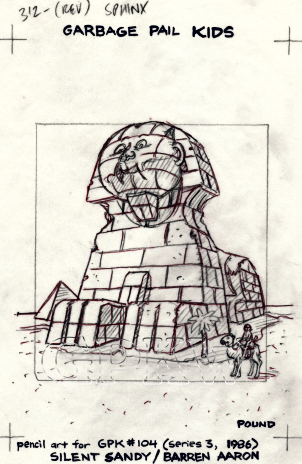 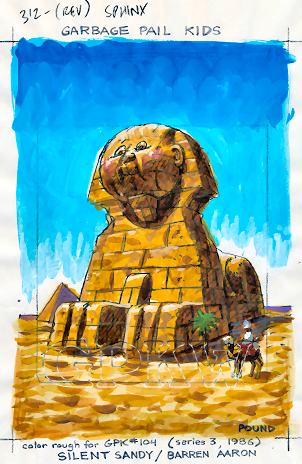
POUND'S TIGHT SKETCH (L) AND COLOR ROUGH (R); 'REV' = REVISED
"The horizontal / vertical was decided by what format best suited the
staging of a particular gag. In this case I think once we saw how John was handling
the forced perspective in his sketch we decided that a vertical format would suit
that monumental approach even better. The figure on camel was added to
extenuate the massive scale even more. An example of the back and forth collaboration
process from both sides." — Mark Newgarden
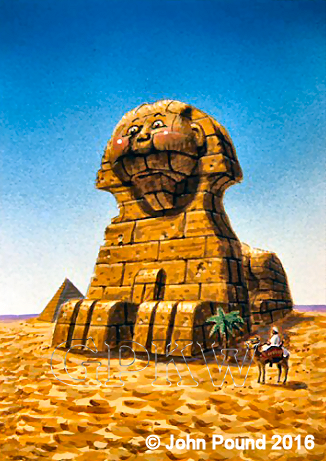
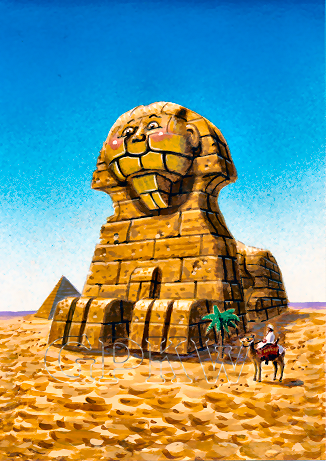
POUND'S
ORIGINAL FINAL ARTWORK (L) AND THE ART DEPARTMENT'S TOUCHED-UP VERSION (R)
"As far as Ben [Solomon], he felt that the image needed more "contrast"
in that "muddy" area in order to print well and had Mae [Jeon] make
her corrections at the behest of the Art Department. A ruckus was duly raised
by NPD after this happened and it proved to be a one-time occurrence with GPK."
— Mark Newgarden (not verbatim)
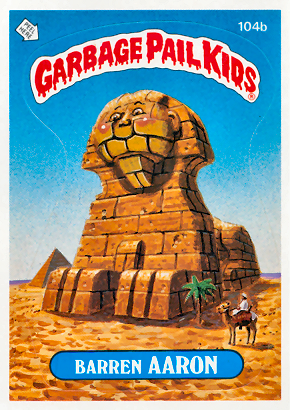
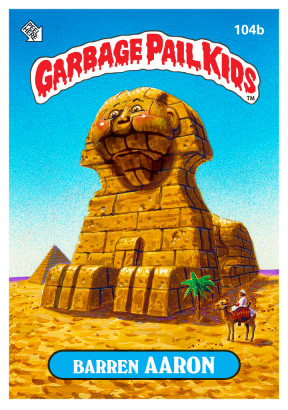
TOPPS'
PRINTED CARD (L) AND DIGITAL MOCK-UP CARD IMAGE BY 'MAD MIKE' BOYAJIAN (R)
BONUS QUESTION...
12. Do you have any off-beat GPK memories or a story
during the heyday of the card releases that you still find amusing to this day?
For example, I love the older lady collector with the 2nd Series completed puzzle
you have pictured in your (amazing) We All Die Alone book … that would've
amused me sitting in an office environment.
Working at Topps I
often felt like I had daily front-row tickets to a private sit-com. Pretty much
everyone there was a real character, from the Arthur the CEO, to Bridget, the
lady that rang up sandwiches in the cafeteria. Here are 3 Bonus GPK Anecdotes
(out of thousands):
Naming Sessions
Stan Hart
is best known as a Mad magazine and TV comedy sketch writer, but he was
also married into the Topps dynasty and associated with them for decades. Stan
was still active on the outer rings of the NPD constellation during my time there.
He didn't get involved in the creative grunt work of GPK, except for sitting in
on our final naming sessions. Stan's names for GPK could sometimes be confounding.
The one I'll never forget was "Les Miserables." (Perfect for the bilingual
8-year-old Broadway musical theatre devotee.) Stan, who was a large, forceful
guy, would stop the meeting dead in its tracks, bellowing "Les Miserables!
Les Miserables!" He did this again and again, in every session, regardless
of the character we were trying to name. Each time we'd chuckle politely and jot
down "Les Miserables." Ten minutes later, like clockwork, Stan would
let out with another "Les Miserables!" all over again; as though none
of us had ever heard it before. More chuckles, more jots…Until next time.
(And as far as I know, "Les Miserables" never made it to a final cut.)
Gutter Medium
It was always a sign of success when
we saw our product's wrappers outside Topps littering the sidewalks and gutters
of New York. This happened with GPK during our first local tests, but it was only
a preview of what was to come. On Tuesdays, after our day at Topps was done, Art
used to drive back into Manhattan and I'd often go along for the ride or to hang
out afterwards at his place in Soho. He'd normally drive over the Brooklyn Bridge
and cut through Chinatown, where one day we both did a double take when we saw
some elderly guy, literally standing on a street corner selling uncut GPK series
2 sheets (it had JUST been released.) We stopped and checked them out- they were
obvious counterfeits with fat Moiré patterns (shot and printed right off
of original Topps press sheets.) How an original uncut sheet made its way into
the hands of the nefarious Chinatown counterfeiters so quickly is still an unsolved
mystery... but it shows how fast these things took off. Not long after this I
was in my local supermarket where I happened across a vending machine dispensing
crude, ersatz GPK stickers. And the very next day I was accosted by a hustler
on the F train peddling bogus GPK watches. I soon became aware of GPK stickers
almost everywhere I went; plastered on streetlights, in elevators, on the subways
and in public restrooms. I felt like Frankenstein, stalked and taunted by own
miserable children!
Major League Baseball
I was
informed, long after the fact, that the major league baseball's Players Association
(who was probably Topps' biggest client) had big, big problems with GPK. Seems
many in the industry were in the thrall of Pat Robertson, Newt Gingrich and others
of that ilk who found GPK a useful punching bag. Evidently, throughout the entire
15 series run, whenever the topic came up, Topps would simply tell them: "Garbage
Pail Kids? No problem. We aren't making those any more." And that would
be that. I can't fathom how they kept that up year in and year out with a straight
face, but …well…that was Topps!
©
Mark Newgarden 2016
THANKS
MARK/MN! |



















